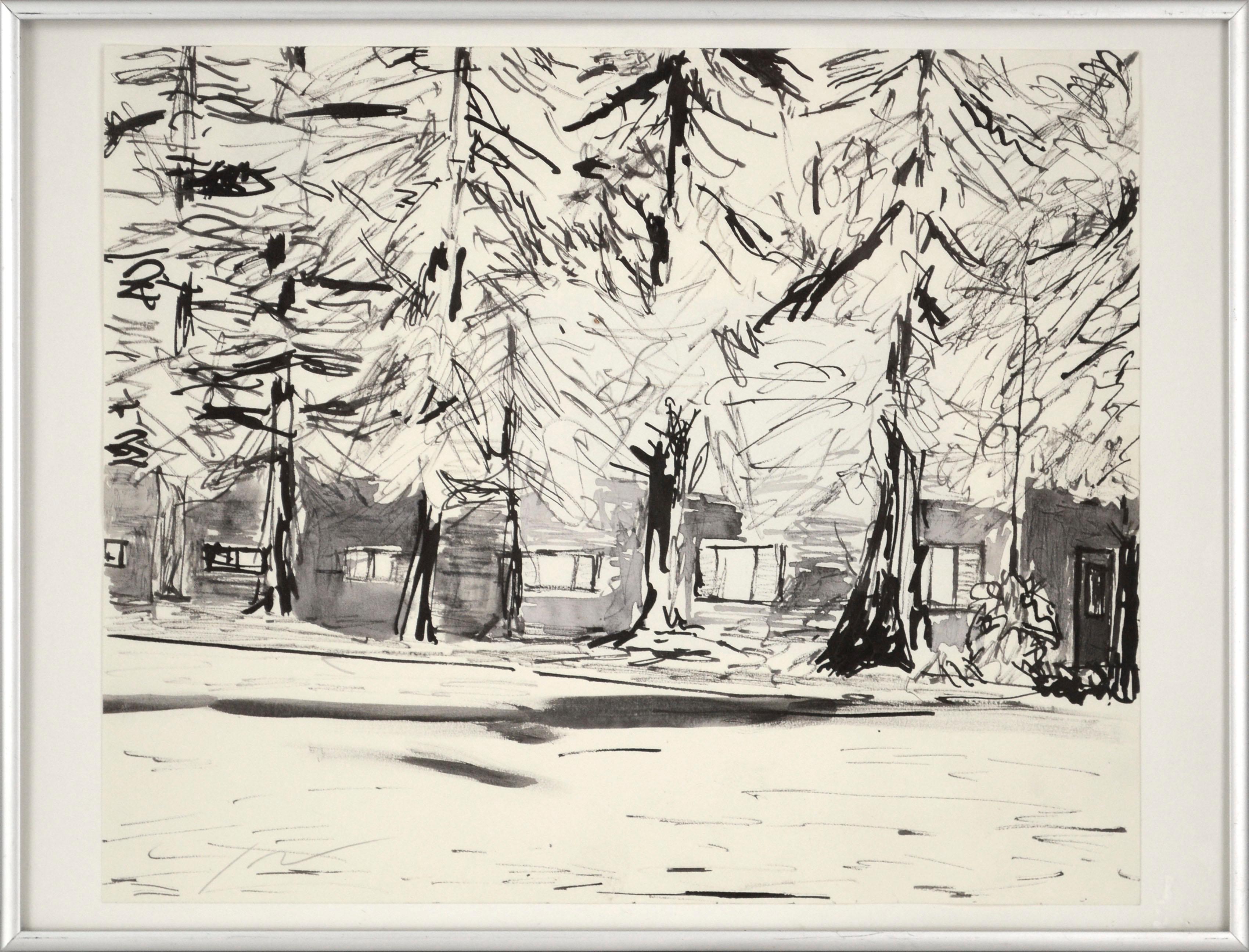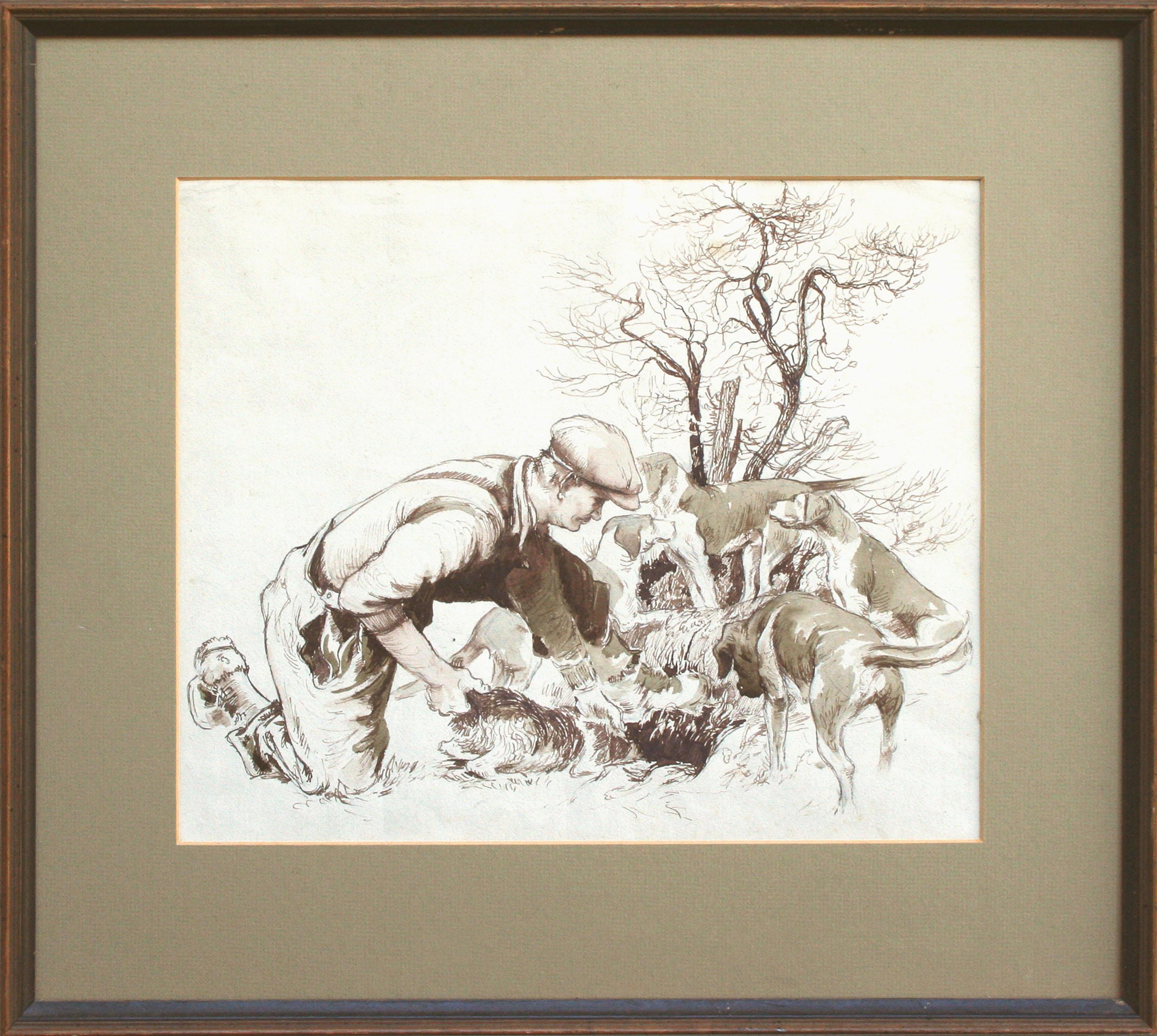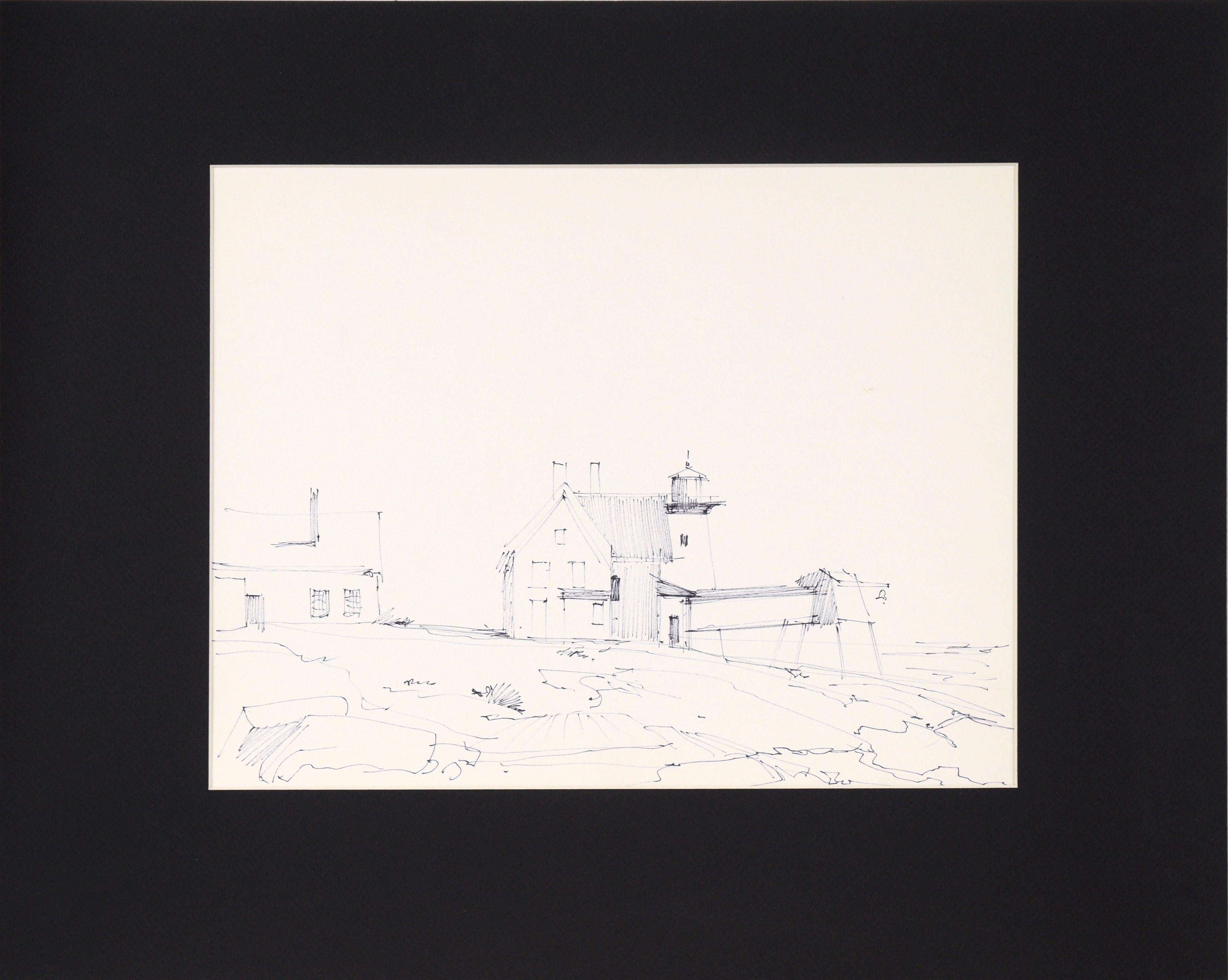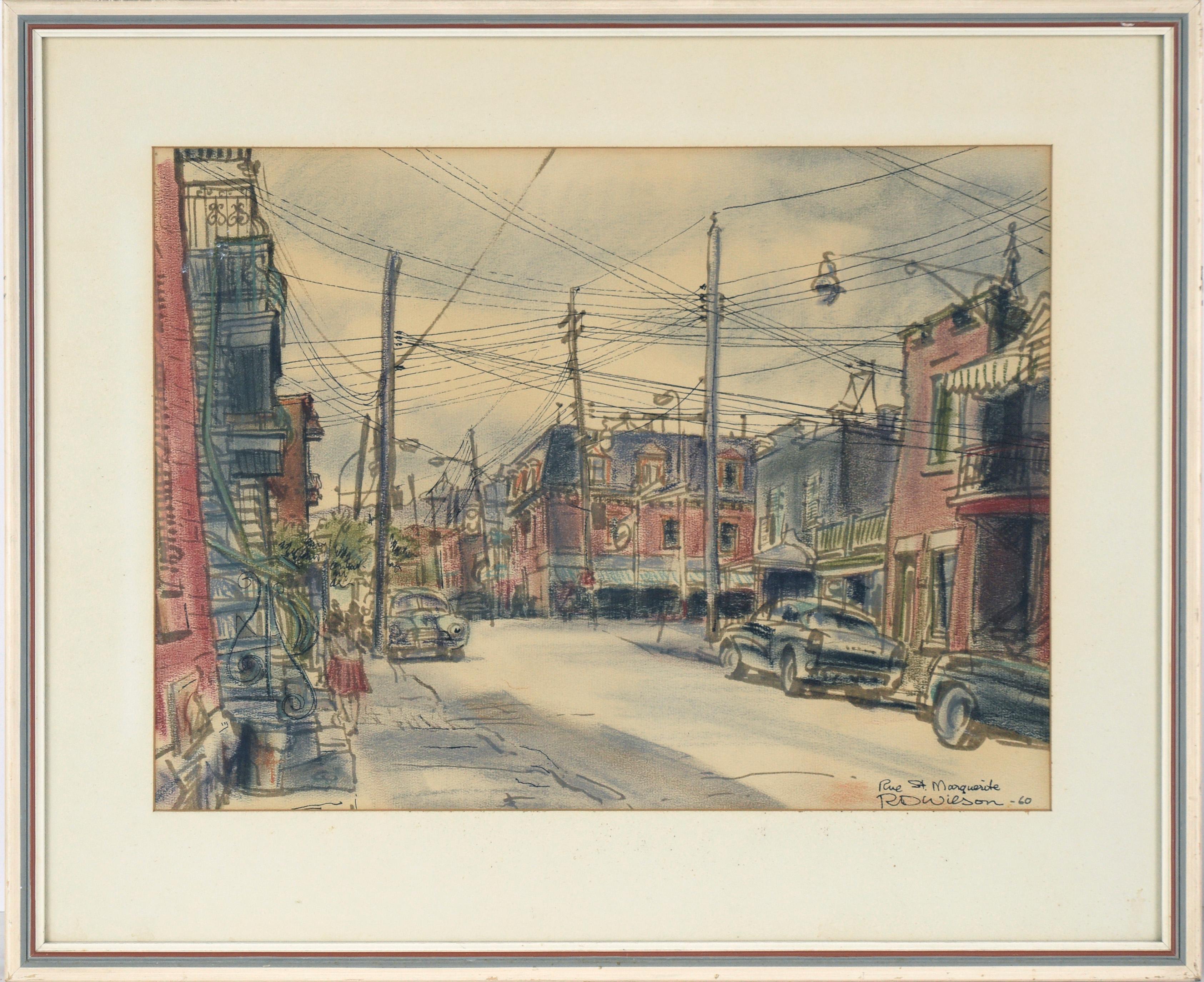Items Similar to Vintage Country Cross Roads Landscape - Pen and Ink Drawing
Want more images or videos?
Request additional images or videos from the seller
1 of 8
M. QuisenberryVintage Country Cross Roads Landscape - Pen and Ink Drawing1974
1974
About the Item
Charming and detailed pen and ink painting of country crossroads with barns and power poles by M. Quisenberry (American, 20th Century). Signed "M Quisenberry '74" lower right corner. Presented in rustic wood frame with glass. Image size: 13"H x 19"W. Framed size: 22"H x 28"W.
- Creator:M. Quisenberry
- Creation Year:1974
- Dimensions:Height: 22 in (55.88 cm)Width: 28 in (71.12 cm)Depth: 1 in (2.54 cm)
- Medium:
- Movement & Style:
- Period:
- Condition:
- Gallery Location:Soquel, CA
- Reference Number:
About the Seller
4.9
Platinum Seller
These expertly vetted sellers are 1stDibs' most experienced sellers and are rated highest by our customers.
Established in 1986
1stDibs seller since 2014
2,549 sales on 1stDibs
Typical response time: <1 hour
- ShippingRetrieving quote...Ships From: Soquel, CA
- Return PolicyA return for this item may be initiated within 14 days of delivery.
More From This SellerView All
- Cabin in the Woods, India Ink Forest Landscape with Redwood TreesBy Michael PaukerLocated in Soquel, CAIndia ink and watercolor landscape in black done with expressive, linear brushstrokes featuring tall redwood trees with cabin windows peaking through the ...Category
2010s American Impressionist Landscape Drawings and Watercolors
MaterialsPaper, Watercolor, India Ink
- On the Hunt - Early 20th Century Figurative Drawing with DogsLocated in Soquel, CAFigurative ink and wash drawing of beagles and a terrier leading the hunter to the quarry by an unknown artist (American, 20th Century). Unsigned. Displayed in a rustic black and bro...Category
1930s American Impressionist Figurative Drawings and Watercolors
MaterialsInk, Paper, Watercolor
- Lighthouse at the Shore — Impressionist Pen and Ink Landscape DrawingBy Laurence SissonLocated in Soquel, CALighthouse at the Shore Maine - Impressionist Original Pen and Ink Drawing Landscape Delicate landscape pen and ink line drawing by listed Ma...Category
1950s American Impressionist Landscape Drawings and Watercolors
MaterialsPaper, Permanent Marker, Ink
- Mid Century Modern Farmhouse Landscape in Watercolor and Ink on PaperLocated in Soquel, CAMid Century Modern Farmhouse Landscape in Watercolor and Ink on Paper Bright, modern landscape by Robin Gay McCline (American, 1928-2008). A line of trees and buildings runs across ...Category
Mid-20th Century American Impressionist Landscape Drawings and Watercolors
MaterialsPaper, Ink, Watercolor
- "Rue St. Marguerite" Montreal Street in Watercolor, Colored Pencil and India InkLocated in Soquel, CA"Rue St. Marguerite" Montreal Street Scene in Watercolor, Pastel, and India Ink Vibrant drawing of Montreal, Canada, by Richard D. Wilson (Canadian, 1920-1994). A street scene of 1960s Montreal, complete with cars, people walking and crisscrossing telephone and power lines...Category
1960s Impressionist Landscape Drawings and Watercolors
MaterialsIndia Ink, Watercolor, Paper, Pastel
- Botanical Study Autumn Grape Leaves #2By Les AndersonLocated in Soquel, CAColorful study of grape leaves in autumn with abstracted elements and a pink/magenta background by California artist Les (Leslie Luverne) Anderson (American, 1928-2009). From the est...Category
Late 20th Century American Impressionist Landscape Drawings and Watercolors
MaterialsWatercolor, Laid Paper
You May Also Like
- Pennsylvania Farmhouse, American Impressionist Landscape, Watercolor on PaperBy Albert Van Nesse GreeneLocated in Doylestown, PA"Pennsylvania Farmhouse" is a beautiful spring landscape with rolling hills and countryside farmhouses. The watercolor on paper is painted by American Impressionist Albert Van Nesse Greene. The painting is a 14" x 19" watercolor on paper, matted, framed under glass, and signed "A V Greene...Category
Early 20th Century American Impressionist Landscape Drawings and Waterco...
MaterialsWatercolor, Archival Paper
- "Bare Tree"By Daniel GarberLocated in Lambertville, NJJim’s of Lambertville Fine Art Gallery is proud to present this piece by Daniel Garber (1880 - 1958). One of the two most important and, so far, the most valuable of the New Hope School Painters, Daniel Garber was born on April 11, 1880, in North Manchester, Indiana. At the age of seventeen, he studied at the Art Academy of Cincinnati with Vincent Nowottny. Moving to Philadelphia in 1899, he first attended classes at the "Darby School," near Fort Washington; a summer school run by Academy instructors Anshutz and Breckenridge. Later that year, he enrolled at the Pennsylvania Academy of the Fine Arts. His instructors at the Academy included Thomas Anshutz, William Merritt Chase and Cecilia Beaux. There Garber met fellow artist Mary Franklin while she was posing as a model for the portrait class of Hugh Breckenridge. After a two year courtship, Garber married Mary Franklin on June 21, 1901. In May 1905, Garber was awarded the William Emlen Cresson Scholarship from the Pennsylvania Academy, which enabled him to spend two years for independent studies in England, Italy and France. He painted frequently while in Europe, creating a powerful body of colorful impressionist landscapes depicting various rural villages and farms scenes; exhibiting several of these works in the Paris Salon. Upon his return, Garber began to teach Life and Antique Drawing classes at the Philadelphia School of Design for Women in 1907. In the summer of that same year, Garber and family settled in Lumbertville, Pennsylvania, a small town just north of New Hope. Their new home would come to be known as the "Cuttalossa," named after the creek which occupied part of the land. The family would divide the year, living six months in Philadelphia at the Green Street townhouse while he taught, and the rest of the time in Lambertville. Soon Garber’s career would take off as he began to receive a multitude of prestigious awards for his masterful Pennsylvania landscapes. During the fall of 1909, he was offered a position to teach at the Pennsylvania Academy as an assistant to Thomas Anshutz. Garber became an important instructor at the Academy, where he taught for forty-one years. Daniel Garber painted masterful landscapes depicting the Pennsylvania and New Jersey countryside surrounding New Hope. Unlike his contemporary, Edward Redfield, Garber painted with a delicate technique using a thin application of paint. His paintings are filled with color and light projecting a feeling of endless depth. Although Like Redfield, Garber painted large exhibition size canvases with the intent of winning medals, and was extremely successful doing so, he was also very adept at painting small gem like paintings. He was also a fine draftsman creating a relatively large body of works on paper, mostly in charcoal, and a rare few works in pastel. Another of Garber’s many talents was etching. He created a series of approximately fifty different scenes, most of which are run in editions of fifty or less etchings per plate. Throughout his distinguished career, Daniel Garber was awarded some of the highest honors bestowed upon an American artist. Some of his accolades include the First Hallgarten Prize from the National Academy in 1909, the Bronze Medal at the International Exposition in Buenos Aires in 1910, the Walter Lippincott Prize from the Pennsylvania Academy and the Potter Gold Medal at the Art Institute of Chicago in 1911, the Second Clark Prize and the Silver Medal from the Corcoran Gallery of Art for “Wilderness” in 1912, the Gold Medal from the Panama-Pacific Exposition in San Francisco of 1915, the Second Altman Prize in1915, the Shaw prize in 1916, the First Altman Prize in 1917, the Edward Stotesbury Prize in1918, the Temple Gold Medal, in 1919, the First William A...Category
Early 20th Century American Impressionist Landscape Drawings and Waterco...
MaterialsCharcoal, Paper
- "Horse Cart"By Daniel GarberLocated in Lambertville, NJJim’s of Lambertville Fine Art Gallery is proud to present this piece by Daniel Garber (1880 - 1958). One of the two most important and, so far, the most valuable of the New Hope Sc...Category
Early 20th Century American Impressionist Landscape Drawings and Waterco...
MaterialsGraphite, Paper
- 1964 "Tree with Blue" Pastel Impressionist Landscape Drawing NYC Female ArtistBy Edith Isaac-RoseLocated in Arp, TXEdith Isaac-Rose "Pastel Landscape Tree with Blue" 1964 Pastel on paper 11"x14" framed gold gallery frame 21.25"x1"x24" Signed and dated lower right in pencil. Came from a portfolio of her work. Born in Chicago in 1929, and neé Ganansky-Teitelbaum, she graduated from The Art Institute of Chicago in 1951 and moved to New York in 1959 where she lived ever since. Taking as her professional name her parents’ first names, Edith was a prolific artist working first as an abstract expressionist then turning in the 1980s to figurative, political work consisting of drawings, paintings, and embroideries which she called “Daily Rage”. She had been represented by the Phyllis Kind...Category
Mid-20th Century American Impressionist Landscape Drawings and Watercolors
MaterialsPaper, Oil Pastel
- 1960s "Cubed Abstract" Pastel Impressionist Landscape Drawing NYC Female ArtistBy Edith Isaac-RoseLocated in Arp, TXEdith Isaac-Rose "Cubed Abstract" 1960s Pastel on paper 6.5"x7.25 unframed Signed in pencil lower right. Came from a portfolio of her work. *Custom framing available for additional charge. Please expect framing time between 3-5 weeks. Born in Chicago in 1929, and neé Ganansky-Teitelbaum, she graduated from The Art Institute of Chicago in 1951 and moved to New York in 1959 where she lived ever since. Taking as her professional name her parents’ first names, Edith was a prolific artist working first as an abstract expressionist then turning in the 1980s to figurative, political work consisting of drawings, paintings, and embroideries which she called “Daily Rage”. She had been represented by the Phyllis Kind...Category
Mid-20th Century American Impressionist Landscape Drawings and Watercolors
MaterialsPaper, Oil Pastel
- "Train Station, " Max Kuehne, Industrial City Scene, American ImpressionismBy Max KuehneLocated in New York, NYMax Kuehne (1880 - 1968) Train Station, circa 1910 Watercolor on paper 8 1/4 x 10 1/4 inches Signed lower right Provenance: Private Collection, Illinois Max Kuehne was born in Halle, Germany on November 7, 1880. During his adolescence the family immigrated to America and settled in Flushing, New York. As a young man, Max was active in rowing events, bicycle racing, swimming and sailing. After experimenting with various occupations, Kuehne decided to study art, which led him to William Merritt Chase's famous school in New York; he was trained by Chase himself, then by Kenneth Hayes Miller. Chase was at the peak of his career, and his portraits were especially in demand. Kuehne would have profited from Chase's invaluable lessons in technique, as well as his inspirational personality. Miller, only four years older than Kuehne, was another of the many artists to benefit from Chase's teachings. Even though Miller still would have been under the spell of Chase upon Kuehne's arrival, he was already experimenting with an aestheticism that went beyond Chase's realism and virtuosity of the brush. Later Miller developed a style dependent upon volumetric figures that recall Italian Renaissance prototypes. Kuehne moved from Miller to Robert Henri in 1909. Rockwell Kent, who also studied under Chase, Miller, and Henri, expressed what he felt were their respective contributions: "As Chase had taught us to use our eyes, and Henri to enlist our hearts, Miller called on us to use our heads." (Rockwell Kent, It's Me O Lord: The Autobiography of Rockwell Kent. New York: Dodd, Mead and Co., 1955, p. 83). Henri prompted Kuehne to search out the unvarnished realities of urban living; a notable portion of Henri's stylistic formula was incorporated into his work. Having received such a thorough foundation in art, Kuehne spent a year in Europe's major art museums to study techniques of the old masters. His son Richard named Ernest Lawson as one of Max Kuehne's European traveling companions. In 1911 Kuehne moved to New York where he maintained a studio and painted everyday scenes around him, using the rather Manet-like, dark palette of Henri. A trip to Gloucester during the following summer engendered a brighter palette. In the words of Gallatin (1924, p. 60), during that summer Kuehne "executed some of his most successful pictures, paintings full of sunlight . . . revealing the fact that he was becoming a colorist of considerable distinction." Kuehne was away in England the year of the Armory Show (1913), where he worked on powerful, painterly seascapes on the rocky shores of Cornwall. Possibly inspired by Henri - who had discovered Madrid in 1900 then took classes there in 1906, 1908 and 1912 - Kuehne visited Spain in 1914; in all, he would spend three years there, maintaining a studio in Granada. He developed his own impressionism and a greater simplicity while in Spain, under the influence of the brilliant Mediterranean light. George Bellows convinced Kuehne to spend the summer of 1919 in Rockport, Maine (near Camden). The influence of Bellows was more than casual; he would have intensified Kuehne's commitment to paint life "in the raw" around him. After another brief trip to Spain in 1920, Kuehne went to the other Rockport (Cape Ann, Massachusetts) where he was accepted as a member of the vigorous art colony, spearheaded by Aldro T. Hibbard. Rockport's picturesque ambiance fulfilled the needs of an artist-sailor: as a writer in the Gloucester Daily Times explained, "Max Kuehne came to Rockport to paint, but he stayed to sail." The 1920s was a boom decade for Cape Ann, as it was for the rest of the nation. Kuehne's studio in Rockport was formerly occupied by Jonas Lie. Kuehne spent the summer of 1923 in Paris, where in July, André Breton started a brawl as the curtain went up on a play by his rival Tristan Tzara; the event signified the demise of the Dada movement. Kuehne could not relate to this avant-garde art but was apparently influenced by more traditional painters — the Fauves, Nabis, and painters such as Bonnard. Gallatin perceived a looser handling and more brilliant color in the pictures Kuehne brought back to the States in the fall. In 1926, Kuehne won the First Honorable Mention at the Carnegie Institute, and he re-exhibited there, for example, in 1937 (Before the Wind). Besides painting, Kuehne did sculpture, decorative screens, and furniture work with carved and gilded molding. In addition, he designed and carved his own frames, and John Taylor Adams encouraged Kuehne to execute etchings. Through his talents in all these media he was able to survive the Depression, and during the 1940s and 1950s these activities almost eclipsed his easel painting. In later years, Kuehne's landscapes and still-lifes show the influence of Cézanne and Bonnard, and his style changed radically. Max Kuehne died in 1968. He exhibited his work at the National Academy of Design, the Art Institute of Chicago, the Carnegie Institute in Pittsburgh, the Memorial Art Gallery of the University of Rochester, and in various New York City galleries. Kuehne's works are in the following public collections: the Detroit Institute of Arts (Marine Headland), the Whitney Museum (Diamond Hill...Category
1910s American Impressionist Landscape Drawings and Watercolors
MaterialsPaper, Watercolor





